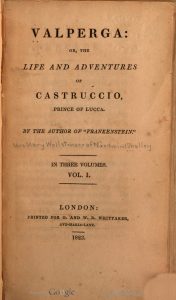August 30th is Mary Shelley’s birthday! There’s no better way to celebrate than to discuss her life, her accomplishments, and her lasting legacy.

Born to Mary Wollstonecraft and William Godwin in 1797, Shelley was practically destined for greatness. Her parents were renowned philosophers, though her mother died soon after her daughter’s birth. Godwin took to educating Shelley, albeit unconventionally. Instead of traditional schooling, Godwin tutored her, taking her on educational adventures and exposing her to intellectuals through his connections as well as through their library.
Eventually–after her father remarried–Shelley was sent to Scotland. It was between trips to Scotland that she met the man she would ultimately marry: Percy Bysshe Shelley. The couple eloped in 1814.

In 1816, the couple traveled to Geneva with several other notable literary figures, including Lord Byron. While there, the group found themselves interested in German ghost stories, eventually challenging themselves to write spooky stories of their own.
This led to Shelley’s most famous work, Frankenstein, but its creation proved a bit of a challenge. When repeatedly asked what she’d be writing about, she frequently became frustrated, being “forced to reply with a mortifying negative.”
Soon enough an idea sprang to mind. Shelley recounts this moment–as well as her own account of Frankenstein’s creation–in the preface to the 1831 edition:
“My imagination, unbidden, possessed and guided me, gifting the successive images that arose in my mind with a vividness far beyond the usual bounds of reverie. I saw—with shut eyes, but acute mental vision,—I saw the pale student of unhallowed arts kneeling beside the thing he had put together. I saw the hideous phantasm of a man stretched out, and then, on the working of some powerful engine, show signs of life, and stir with an uneasy, half vital motion. Frightful must it be; for supremely frightful would be the effect of any human endeavour to mock the stupendous mechanism of the Creator of the world. His success would terrify the artist; he would rush away from his odious handywork, horror-stricken. He would hope that, left to itself, the slight spark of life which he had communicated would fade; that this thing, which had received such imperfect animation, would subside into dead matter; and he might sleep in the belief that the silence of the grave would quench for ever the transient existence of the hideous corpse which he had looked upon as the cradle of life. He sleeps; but he is awakened; he opens his eyes; behold the horrid thing stands at his bedside, opening his curtains, and looking on him with yellow, watery, but speculative eyes.”
–Preface to Frankenstein
With an idea in mind, Shelley set out to write the short story that, when finished, would be the basis for Frankenstein. By 1817, she had finished writing the novel. It was published on New Year’s Day of 1818.
Frankenstein’s legacy endures today, and is Shelley’s most famous work. The literary and film world are filled with adaptations and retellings, and frequent references to the story–whether that be a legendary movie monster of the same name or a small, off-hand reference–can be found throughout the world. It’s a staple of Gothic literature and is, arguably, one of the first science-fiction novels ever written.
So, this August 30th, celebrate Mary Shelley by taking a peek at Frankenstein. If you’ve already read Frankenstein or are looking for something a little less spooky, you may also want to check out her other works, provided below.
For more information on Mary Shelley, click here.




